The most popular ideas of robots on Kickstarter
Hello!
In my last post about the search for ideas of robots, the distinguished nemilya in the commentary suggested an excellent idea, or rather, a method of searching for ideas for creating robots - this is the well-known crowdfunding project Kickstarter.
I started to collect, at first for myself, the top mostfunded popular projects, but after thinking I decided that I could get valuable comments from the habrovchan and habrovchanok at my favorite Habré.
Below is the Top15 of the most successful Kickstarter projects from the “Robots” category, and even below are some reflections on this sample.
')
Selection of all projects here , so as not to overdo it with the links in this entry.
Also, I don’t cite the amount of money that these projects have collected, because it is unethical to consider other people's money, I’ll just write that the projects below have raised from 40 to 361 thousand dollars on Kick Starter.

MOSS, a cubes roboconstructor
A set of modules for creating various robots for children and teenagers.
More details .
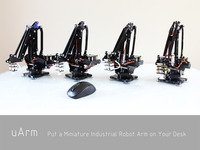
uArm, miniature industrial manipulator
Computer-controlled miniature desktop manipulator.
More details .
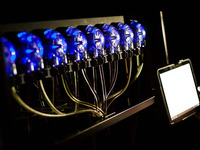
Bartendro, cocktail mixing robot
Open source project of a robot to create cocktails.
More details .
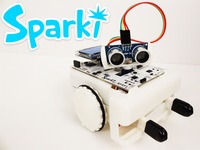
Sparki, a simple robot on Arduino
A simple miniature robot with sensors and on Arduino, which does not require high programming skills.
More details .
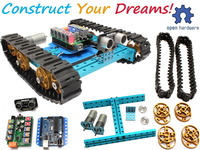
Makeblock, a designer to create a robot
A set of parts to create an interesting tracked robot.
More details .

Romo, the robot from the smartphone
Riding platform that turns your smartphone into a robot.
More details .
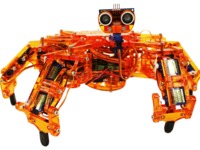
Hexy the Haxapod, cheap six-legged robot
An open project to create a cheap hexapod robot.
More details .
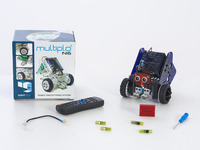
Multiplo, creating your own robot
System for designing and building a robot on your own ideas, open source.
More details .

OpenROV, open-air underwater robot
Kits for creating an underwater robot for research and training.
More details .
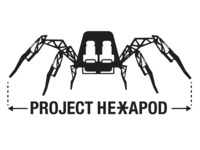
Stompy, big walking robot
The project to create a large, 5.5-meter walking robot with space for the operator.
More details .

Botiful, telepresence robot for Android
"Riding Trolley" for Android device, turning it into a telepresence robot.
More details .
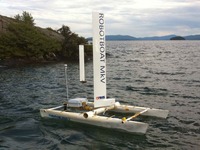
Robot Mark VI, floating sailing robot
Robot with sails to explore the ocean.
More details .

KIBO, educational robot for children from wooden cubes
Roboconstructor of wooden cubes with electronics, from which children can create robots. The method of visual programming of robots from blocks was also applied.
More details .
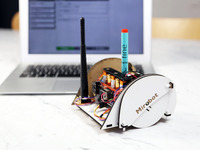
Mirobot teaching WiFi robot for kids
Open-source do-it-yourself robot for teaching children new technologies and programming.
More details .

TJ, puppet robot
Animatronic puppet for children, moving with the help of servos and Arduino.
More details .
And now let's sort the thoughts on this sample a little.
7 projects from the top are educational projects, 2 telepresence robots extending the functions of smartphones, 1 cheap platform-hexapod, 1 miniature desktop manipulator, 1 underwater research and 1 surface research sailing, as well as a huge walking robot with a place for the operator and 1 robot bartender.
What can "squeeze" ordinary robotics from this set of information?
Kick Starter's favorites are educational projects, which is understandable, people sponsor what they are interested in, and projects for introducing them to the world of robotics, developing design, prototyping and programming skills for themselves and for their children are more important than some day a flying combat reconnaissance drone or a farmer robot hawk to save crops that are unlikely to be donated to donators. Such projects themselves will find funding without crowdfunding.
As for me, of all these projects, the most interesting are exactly how robots, how the application of technologies and ideas is an underwater ocean robot, a catamaran robot with an elegant solution in the form of sailing traction and a robot barman.
Learning "cubes", I think, on the contrary, are harmful, because They do not allow trainees to develop by offering a plug & play approach, developing a bad habit of thinking about creating robots superficially and within the framework of ready-made designer blocks. But already from 9-10 years old, children from Arduino could also collect something and even take a soldering iron under the strict guidance of adults, thereby developing a useful skill and in-depth learning the world of electronics, electrical engineering and mechatronics. With a limited set of cubes, well, no imagination and space for creativity. It may even go so far that a small person simply cannot think beyond the finished cube-sensor, “seeing” the space by 20 cm, whereas custom he could assemble the sensor 9 times more efficiently.
What projects were not considered:
- debug board for creating robots,
- sailing robot for cleaning oil stains on the water,
- telepresence robot from a netbook,
- flying drone platform for developing specialized applications for such drones,
- robo-drawing hand, for an online training course,
- powerful controller for robots,
- robo-hand, printed on a 3D-printer,
- the balancing two-wheeled robot on Arduino,
- anthropomorphic animatronic robot,
- robot artist, “manually” drawing sketches,
- manipulator
- animatronics robots for teaching microcontrollers, mechanics and the creation of paper crafts,
- tracked robot controlled from a smartphone,
- a robot for growing biomass in the sea and turning it into biofuel,
- arena for robot battles,
- a robot for competition projects of school teams,
- sets of robots on the Raspberry Pi for learning or hobbies,
- Roomba with laptop and Kinect,
- set to create a robot with Arduino,
- creation of a robot for robot competitions,
- a robot that can roll into a ring,
- another competition robot,
- robotic bot for crossing the Atlantic Ocean,
- universal robot platform,
- one more robot for school competitions,
- likewise, a competition robot,
- 5 more projects of robots for competitions,
- make friends Raspberry Pi and quadrocopter,
- telepresence robot in the form of clothes hangers,
- a robot for LEGO competitions,
- ROV-robot (Remotely Operated Robot, remotely controlled robot) for underwater research,
- 4 more projects for robot competitions,
- cocktail robots as an art project,
- and again a robot for competition,
- art robot robot, driving on the table,
- a robot for competition.
Below are more projects of robots that did not collect the required amount on Kick Starter or were canceled:
- six-spoke robot wheel,
- gears designer
- again 2 projects of robots for competitions,
- controller for collector / brushless DC motors,
- image recognition system for robots,
- plush learning robots managed with Android,
- robo chair for non-walking people,
- six-wheeled Martian rover.
The general impression now, after a few hours of viewing Kickstarter and writing this text, is that they are all utilitarian, domestic, no scope, no power, like the same industrial robots, robots to work with nuclear materials (which started the development of robotics) , with some exceptions.
The question is - do you think, dear habrovchane, does Kickstarter have a chance to get into the top project, which is not cubes, a telepresence cart for a smartphone or a cheap plastic robot with the sole purpose of attracting the attention of others to robots?
Thank!
In my last post about the search for ideas of robots, the distinguished nemilya in the commentary suggested an excellent idea, or rather, a method of searching for ideas for creating robots - this is the well-known crowdfunding project Kickstarter.
I started to collect, at first for myself, the top most
Below is the Top15 of the most successful Kickstarter projects from the “Robots” category, and even below are some reflections on this sample.
')
Selection of all projects here , so as not to overdo it with the links in this entry.
Also, I don’t cite the amount of money that these projects have collected, because it is unethical to consider other people's money, I’ll just write that the projects below have raised from 40 to 361 thousand dollars on Kick Starter.

MOSS, a cubes roboconstructor
A set of modules for creating various robots for children and teenagers.
More details .

uArm, miniature industrial manipulator
Computer-controlled miniature desktop manipulator.
More details .

Bartendro, cocktail mixing robot
Open source project of a robot to create cocktails.
More details .

Sparki, a simple robot on Arduino
A simple miniature robot with sensors and on Arduino, which does not require high programming skills.
More details .

Makeblock, a designer to create a robot
A set of parts to create an interesting tracked robot.
More details .

Romo, the robot from the smartphone
Riding platform that turns your smartphone into a robot.
More details .

Hexy the Haxapod, cheap six-legged robot
An open project to create a cheap hexapod robot.
More details .

Multiplo, creating your own robot
System for designing and building a robot on your own ideas, open source.
More details .

OpenROV, open-air underwater robot
Kits for creating an underwater robot for research and training.
More details .

Stompy, big walking robot
The project to create a large, 5.5-meter walking robot with space for the operator.
More details .

Botiful, telepresence robot for Android
"Riding Trolley" for Android device, turning it into a telepresence robot.
More details .

Robot Mark VI, floating sailing robot
Robot with sails to explore the ocean.
More details .

KIBO, educational robot for children from wooden cubes
Roboconstructor of wooden cubes with electronics, from which children can create robots. The method of visual programming of robots from blocks was also applied.
More details .

Mirobot teaching WiFi robot for kids
Open-source do-it-yourself robot for teaching children new technologies and programming.
More details .

TJ, puppet robot
Animatronic puppet for children, moving with the help of servos and Arduino.
More details .
And now let's sort the thoughts on this sample a little.
7 projects from the top are educational projects, 2 telepresence robots extending the functions of smartphones, 1 cheap platform-hexapod, 1 miniature desktop manipulator, 1 underwater research and 1 surface research sailing, as well as a huge walking robot with a place for the operator and 1 robot bartender.
What can "squeeze" ordinary robotics from this set of information?
Kick Starter's favorites are educational projects, which is understandable, people sponsor what they are interested in, and projects for introducing them to the world of robotics, developing design, prototyping and programming skills for themselves and for their children are more important than some day a flying combat reconnaissance drone or a farmer robot hawk to save crops that are unlikely to be donated to donators. Such projects themselves will find funding without crowdfunding.
As for me, of all these projects, the most interesting are exactly how robots, how the application of technologies and ideas is an underwater ocean robot, a catamaran robot with an elegant solution in the form of sailing traction and a robot barman.
Learning "cubes", I think, on the contrary, are harmful, because They do not allow trainees to develop by offering a plug & play approach, developing a bad habit of thinking about creating robots superficially and within the framework of ready-made designer blocks. But already from 9-10 years old, children from Arduino could also collect something and even take a soldering iron under the strict guidance of adults, thereby developing a useful skill and in-depth learning the world of electronics, electrical engineering and mechatronics. With a limited set of cubes, well, no imagination and space for creativity. It may even go so far that a small person simply cannot think beyond the finished cube-sensor, “seeing” the space by 20 cm, whereas custom he could assemble the sensor 9 times more efficiently.
What projects were not considered:
- debug board for creating robots,
- sailing robot for cleaning oil stains on the water,
- telepresence robot from a netbook,
- flying drone platform for developing specialized applications for such drones,
- robo-drawing hand, for an online training course,
- powerful controller for robots,
- robo-hand, printed on a 3D-printer,
- the balancing two-wheeled robot on Arduino,
- anthropomorphic animatronic robot,
- robot artist, “manually” drawing sketches,
- manipulator
- animatronics robots for teaching microcontrollers, mechanics and the creation of paper crafts,
- tracked robot controlled from a smartphone,
- a robot for growing biomass in the sea and turning it into biofuel,
- arena for robot battles,
- a robot for competition projects of school teams,
- sets of robots on the Raspberry Pi for learning or hobbies,
- Roomba with laptop and Kinect,
- set to create a robot with Arduino,
- creation of a robot for robot competitions,
- a robot that can roll into a ring,
- another competition robot,
- robotic bot for crossing the Atlantic Ocean,
- universal robot platform,
- one more robot for school competitions,
- likewise, a competition robot,
- 5 more projects of robots for competitions,
- make friends Raspberry Pi and quadrocopter,
- telepresence robot in the form of clothes hangers,
- a robot for LEGO competitions,
- ROV-robot (Remotely Operated Robot, remotely controlled robot) for underwater research,
- 4 more projects for robot competitions,
- cocktail robots as an art project,
- and again a robot for competition,
- art robot robot, driving on the table,
- a robot for competition.
Below are more projects of robots that did not collect the required amount on Kick Starter or were canceled:
- six-spoke robot wheel,
- gears designer
- again 2 projects of robots for competitions,
- controller for collector / brushless DC motors,
- image recognition system for robots,
- plush learning robots managed with Android,
- robo chair for non-walking people,
- six-wheeled Martian rover.
The general impression now, after a few hours of viewing Kickstarter and writing this text, is that they are all utilitarian, domestic, no scope, no power, like the same industrial robots, robots to work with nuclear materials (which started the development of robotics) , with some exceptions.
The question is - do you think, dear habrovchane, does Kickstarter have a chance to get into the top project, which is not cubes, a telepresence cart for a smartphone or a cheap plastic robot with the sole purpose of attracting the attention of others to robots?
Thank!
Source: https://habr.com/ru/post/227489/
All Articles